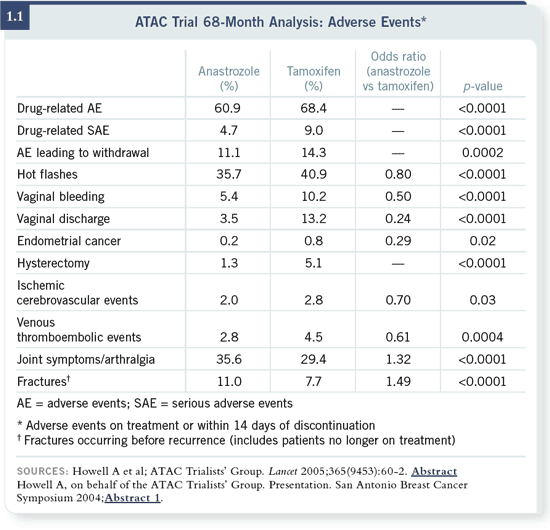|

Selection of adjuvant endocrine therapy for postmenopausal patients with
ER-positive tumors
My bias is to use aromatase inhibitors rather than tamoxifen as adjuvant
endocrine therapy, not because I’m convinced that they are dramatically
better, but because I believe the toxicity profile is better (1.1). With tamoxifen,
I was always concerned about deep vein thromboses and thromboembolic
disorders, and I ordered lots of ultrasounds of the lower extremities. I was less
concerned about uterine carcinoma, in comparison, and reserved the vaginal
ultrasounds for the patients who had dysfunctional bleeding.
When I think about the aromatase inhibitors, my feeling has always been, “I
would rather deal with osteoporosis than breast cancer recurrence or thromboembolic
disorders.” If you look at the list of toxicities of the two medications,
in many areas they overlap, but as a general gestalt, I believe from talking to
patients that, for the most part, the aromatase inhibitors are better tolerated.
I have a fair number of patients who have had problems with arthralgias on
aromatase inhibitors, and I’ve switched medications when needed, but as a
general rule, I use more aromatase inhibitors than tamoxifen. To monitor the
effects on bone, I obtain annual bone density tests and follow them closely.
I start everybody on calcium and vitamin D, and I’m big on exercise. I believe
probably the best complementary data we have is that exercise is good for you.
Also, bisphosphonates can be used.
I select an aromatase inhibitor based on the clinical trial data. Up front, I use
anastrozole or letrozole, based on the ATAC (Howell 2005) or BIG FEMTA
(Thürlimann 2005) data. If I’m crossing over from tamoxifen, I’ll switch
to exemestane or anastrozole, and if the patient has completed five years of
adjuvant endocrine therapy, I’ll use letrozole.
— Richard Zelkowitz, MD
When I look at the data comparing the aromatase inhibitors to tamoxifen, I
note that we have 68 months of follow-up on the ATAC trial, which means
the majority of patients have completed their therapy and approximately a year
of follow-up afterwards (Howell 2005). Clear evidence has emerged of the
efficacy of up-front adjuvant aromatase inhibitors compared to tamoxifen, and
they have a side-effect benefit as well.
The five-year toxicity data are very favorable for the aromatase inhibitors
compared to tamoxifen, because the three life-threatening toxicities —
endometrial cancer and arterial and venous vascular events — were all
significantly less with anastrozole (1.1). Endometrial cancer is associated with
a 15 percent mortality rate. When we look at hip fractures, which are also
life threatening, the incidence was low and really not different at all between the patients on anastrozole and those on tamoxifen. Tony Howell recently
reported on the cardiac death data, which were 49 versus 46 — really no
difference at all after five years (Howell 2005).
— Rowan Chlebowski, MD, PhD
Side effects associated with endocrine therapy
Hot flashes are the major complaint with hormonal therapy, and I give out a
lot of pamphlets to patients on how to manage this side effect. Otherwise, our
patients have not experienced a great deal of trouble with tamoxifen, nor have
we seen a great deal of arthralgias in patients on aromatase inhibitors. I believe
it’s important for patients to know that they have choices and that they are not
locked into one therapy. If a patient experiences side effects that impact her
quality of life, then she can have a dialogue with her physician to decide what
to do next.
— Nancy Sokolowski, RNC, OCN

|

